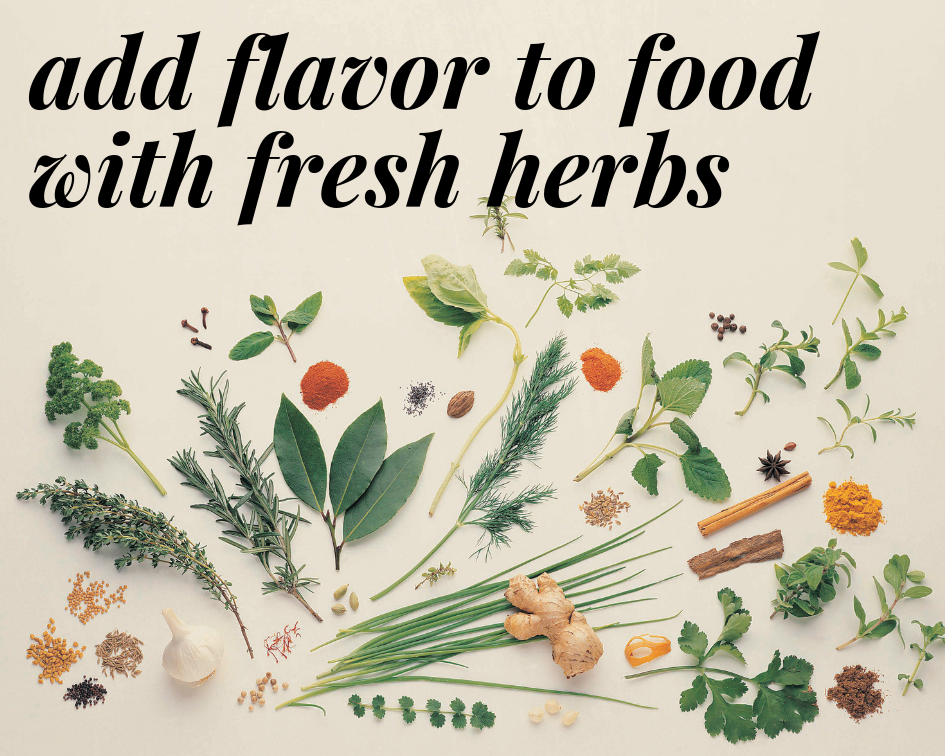Fresh herbs will brighten up the flavors of a dish in an instant. Gone are the days of needing a large garden to grow them. Nowadays, fresh herbs are sold pre-packaged in the produce area of grocery stores. Some markets, like Trader Joes, sell individual plants that’ll sit perfectly on the counter in a kitchen garden. We’ve chosen to spotlight seven of our favorite herbs, describe their characteristics, and, of course, give you links to Blue Ribbon recipes where fresh herbs add pops of flavor to the dish.
Tips for Cooking With Fresh Herbs
- When purchasing herbs, check for vibrant color and aroma.
- When cutting the herb, make sure to use a sharp scissor so the herb is not crushed.
- Fresh herbs should be added towards the end of the cooking process for a bigger pop of flavor.
- If substituting fresh herbs for dried ones, you may need to double or triple the amount. Dried herbs are concentrated and have a more potent flavor.
- Don’t wash herbs until you’re ready to use them. Excess moisture will cause them to spoil faster.
- To store soft herbs (like parsley, cilantro, mint, and dill), pour water in a small glass jar and place the herbs in the jar. There should be just enough water to make sure the herb stems are covered. Then loosely place a resealable plastic bag over the jar (do not seal the bag). When the water beings to become discolored, change it.
- Basil, though, is best stored on the counter and not in the fridge (it will turn black).
- To store woody herbs (like rosemary, chives, thyme, sage), lightly dampen a paper towel and loosely wrap it around the herbs. Then, place the herbs in an airtight bag.
- Fresh herbs will last up to two weeks (or longer) when stored properly.
Popular Herbs for Cooking
Basil
You can’t make pesto or a Caprese salad without basil. It may be the most popular fresh herb in the United States. With a peppery, sweet, and floral flavor, basil is probably one of the most popular herbs. It’s delicious with meat, seafood, and tomatoes. It’s often associated with Italian food.
Cilantro
Some would say that cilantro (also known as coriander) has a soapy flavor. Others say it has a bright, citrusy flavor. Regardless of how it tastes to your taste buds, it’s a necessity in Mexican and Asian cooking. Cilantro is great in recipes for salsa, fish, chicken, and, of course, guacamole.
Dill
The fronds of dill have an anise-like flavor; others think it’s more of an earthy flavor. Popular in European and Scandinavian cuisine, it pairs beautifully with seafood. Also try dill in potato salad, eggs, potatoes, salads, and dressings.
Chives
Chives have a mild onion flavor. They’re most known as a garnish when snipped but are also delicious added to mashed potatoes, eggs, sprinkled over chicken or added to dressing.
Flat-leaf (Italian) Parsley
With its clean, light flavor, parsley will add a touch of a fresh green flavor (aka grassy flavor) to a dish. It’s typically added to sauces and sprinkled over a dish when ready to serve. It can be a substitute for basil in pesto and added to pasta dishes. Curly parsley is also available but that’s best for garnish on a plate.
Rosemary
Rosemary is a very pungent herb with a woodsy, pine-like flavor. Add the stems of rosemary, sparingly, to chicken, roasted veggies, tomato sauces, pork chops, grilled fish, and sauces. It’s very popular in Mediterranean cuisine.
Sage
Sage and turkey go together like peas and carrots. But there are many other uses for this woodsy, peppery herb. Try it in a risotto, with roasted beef or pork, and with potatoes. It also makes a lovely sauce when browned in butter.
Blue Ribbon Recipes Packed With Herbs
Oven Roasted Potatoes With Olive Oil
Tuna Patties With Lemon Dill Sauce
Tomato Mozzarella Salad With Balsamic Dressing
Spaghetti Salad With Balsamic and Basil Dressing
